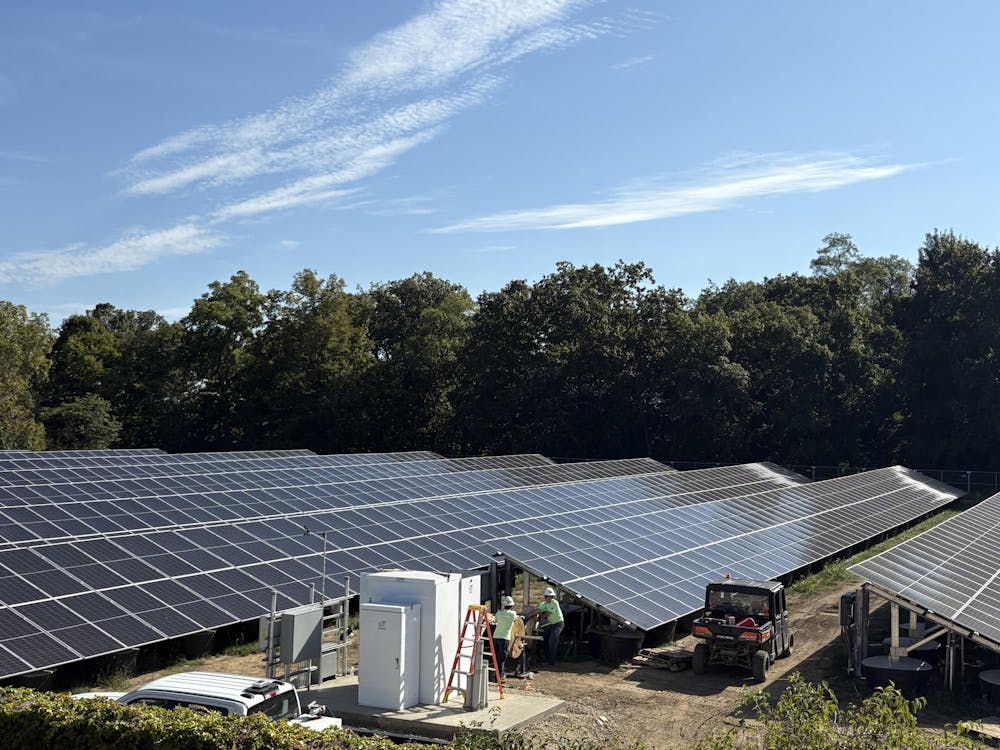Nestled behind Hillcrest Hall on Miami University’s Western campus lies Miami’s newest energy initiative: a 2.26 acre solar array.
After a $5 million donation from Miami alumni passionate about sustainability, and nearly a year of installation work, the project is in its final phase of installation and is expected to be providing power to Miami starting this October.
Director of sustainability Olivia Herron said the project, along with the Millett geothermal fields currently under construction, will reduce Miami’s emissions by nearly 10% and push it further toward its 2040 carbon neutrality goal.
The array sits atop the existing western geothermal wellfield, putting the existing land to use in supporting two kinds of energy production.
“We would never be able to build or do anything on top of this field, so this is the perfect opportunity to utilize this land for its peak value,” said Joel Fellman, electrical engineer project manager.
Herron said the project is special because it will power on-campus learning initiatives and physical facilities. While it is common for solar panel sites to be blocked off, Miami will open the park to the public. The future “Sharon and Graham Mitchell Sustainability Park” will include amenities such a path circling the area, entrance gates and educational signage. The park is named for Sharon and Graham Mitchell, Miami mergers and alumni whose donation made the park possible.
“I’m really excited about the park elements of the solar project,” Herron said. “I think that’s really unique to what Miami is doing.”
Associate teaching professor George Ricco said he looks forward to using the site as an educational resource. Energy Systems and Sustainability (ECE 291) involves 10 weeks of site visits. In the past, he has taken students to visit off-campus sites, but he said Miami’s site will offer several new learning opportunities for his students.
Ricco said the size and capacity of the 2-megawatt facility compared to nearby sites is one of its advantages. He is also excited for students to meet local professionals involved in the energy production process and gain a better understanding of where their energy comes from. The site will provide hands-on opportunities for students to practice calculations.
“I think it’s just an honor and privilege to see this in the field,” Ricco said.
Fellman said the solar project is also beneficial in allowing Miami to be more energy independent. Once the final step of feeder wires being connected to alternating current (AC) combiner boxes is completed, solar energy harvested by the panels will travel to Miami’s substation, where it will be distributed as needed around campus.
Because Miami has its own distribution grid, the university can go “island mode” in the event of a serious power outage in the Duke grid, allowing one half to one third of the campus to remain independently powered.
Enjoy what you're reading?
Signup for our newsletter
“We have a very reliable, durable infrastructure in the grid,” Fellman said.
The project plans to create educational opportunities beyond class visits, as well. Herron said the educational signage, once installed, will aim to inform park visitors on how the solar field works. Different facets such as panels, combiner boxes and more will each have their own sign explaining their role in the energy production process.
“We’re really trying to utilize this for its educational value,” Herron said.
Herron said she also hopes to effectively inform the public about how much energy the new solar array is producing. One way this will be done is by updating the sustainability wall in the Armstrong Student Center to show data visualizations of energy production. Because the energy produced will be diffused around campus, Herron said she hopes to communicate the amount in a uniquely-Miami way by drawing comparisons between the amount of energy produced and the amount of energy used by different buildings on campus.
Students involved in data analytics will be learning through this process of informing the public by working with Herron to create data visualizations and infographics based on production data.
“We thought it would be a neat, Miami-specific student project,” Herron said.
The park aspect of the project will be going out for bid in the coming weeks, with the expectation that students will be able to use the park before they leave next semester.




